Wanted to share and looking for further suggestions for improvement after my time in the wind tunnel.
Tested flat pedals + Alphafly running shoes, determined they would cost ~5-8 watts, 30 seconds on 40 km at 40 kmh, or up to 0.01 CdA versus Speedplay Aero + Laced Sworks shoes. Gen 1 alphafly (pointed heel) a bit faster than Gen 3. Note that a less aero cycling shoe vs a less huge running shoe would probably be a smaller difference. 30 seconds is a lot, but I think I am going to do flat pedals still for the 40 km duathlon (two transitions bike/run), given how often I fumble with my shoes when tired. Lab tests + my own experience suggest (carbon plated) running shoes are just as a efficient as road shoes in terms of power at steady state (**when the fit/position is right, seat goes a bit higher with running shoes being higher).
The POC Procen beat out the Giro Aerohead and Selector by a significant amount.The biggest gain of the day was clearly switching from the Zoot ‘aero’ FZ racesuit to the Huub (Anemoi 2 | 22PLUS Tri Suit Bonded), a CdA improvement of at least 0.013.
Kinda surprised that my slightly longer aero socks (Rule 28) were slower than my favorite Sockeloen 468 socks by quite a decent bit.Keeping my head down lower was faster, obviously, but not by as big an amount as the above mentioned changes. Perhaps this helmet is less sensitive to that.My prototype aero sensor I am working on was a tiny bit faster despite being a hockey puck. Position in front of hands and then helmet likely was important there.
Biggest challenge to figure out improvements on was position. Photos of my best tested position are attached. It was difficult to get much improvement.
Seems that having my hands most fully in front of my face (nose not visible in front photo) made the most differenceAlso looks like the angle of the “Align Wings” of the arm rests of the AeroCoach bars made a difference, more parallel with the flow better (we didn’t specifically test this, we tried to test wider and narrower arms, but looking back at the photos it seems like in moving them we tilted them at an angle to the wind more, and that was the problem and why moving them back to narrow didn’t help as much). Anyone have experience with that?
More photos and a bit more discussion on my blog: https://syllepsis.live/…-in-the-wind-tunnel/
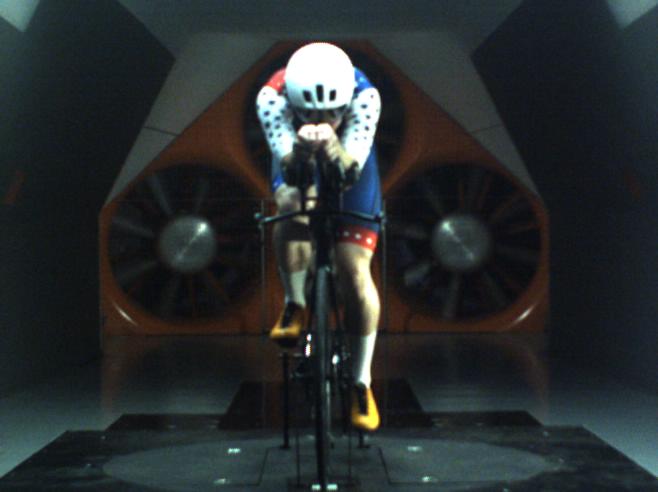
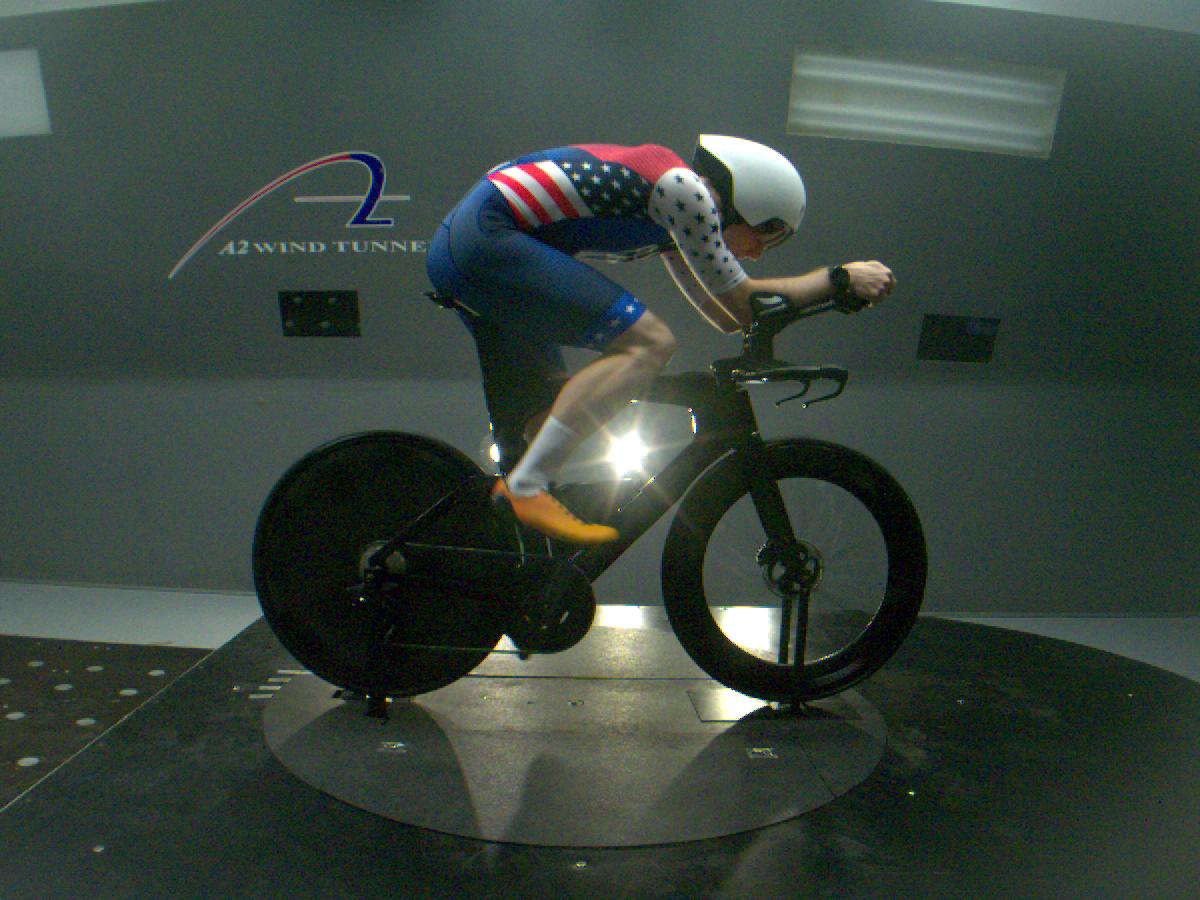
Wind Tunnel 2024-06-18 Colin Catlin - shared.xlsx
Looks like a I didn’t upload the pictures correctly of the best position. Here they are:
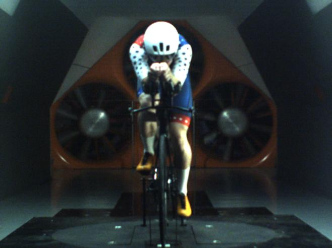
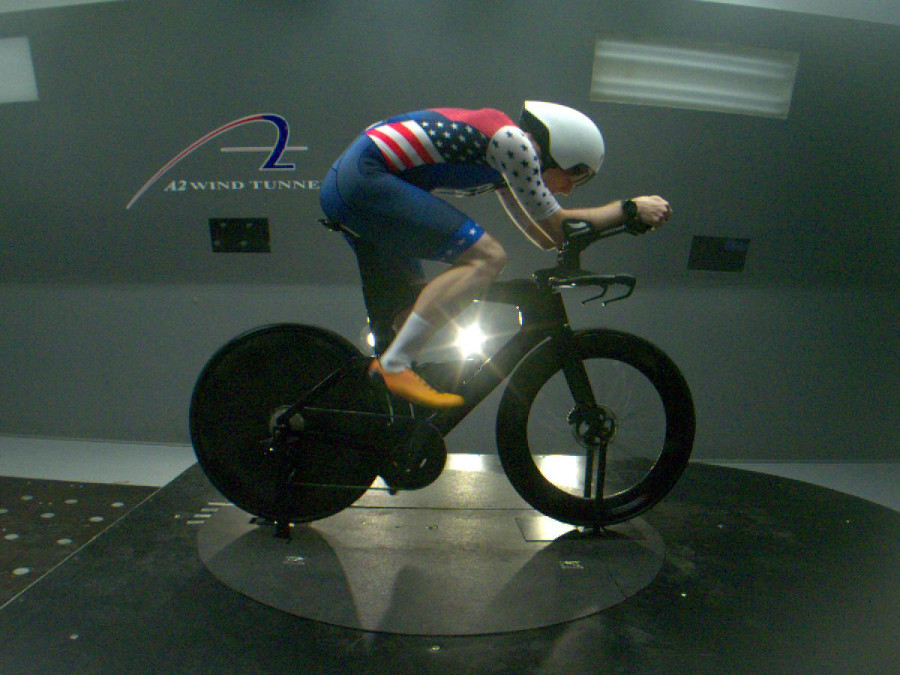
I read (not every word) down through your blog as well and have a couple of comments for you.
- Studies in a lab that show flat pedals with running shoes are as efficient as cycling shoes in most every case. However, that is a very sterile environment where all you have to do is concentrate on pedaling. You are not steering, you are not hitting bumps, you are not going around other riders and the subjects are probably not nearly as oxygen deprived as you feel riding the aero position late in a 40K with another run to come. In my experience, I quickly made up any stagger on guys using platforms and if there was a hill, the power difference was even more obvious. Also, as a long-time cyclist, you (I hope) probably spin a lot higher rpm than the average cyclist which is much harder when not connected to the pedals.
- The last three duathlons I have raced had 8 out of 9 podium positions occupied by 50+ athletes. This is partly due to field size/overall competitiveness and partly because those duathletes really know their business. Your supposition that rich, older guys are taking drugs is probably not unfounded, but they are doing Ironman, not some duathlon that nobody knows about and don’t even understand (what, there’s no swim?).
I’m still riding a 2008 P2C with mid-2000s carbon front/disc cover rear wheel and I’m faster now than I was in my 30’s on the bike. My position has been refined over 20 years and I can ride 40K an hour on watts that would make you laugh. The skinsuit, better tires (I’m talking about you Tufo, you vulcanized, tubular tape nightmare), narrow q-factor and plenty of other small changes mean I’m way more efficient.
Unfortunately, I now run 6-7 minute miles instead of 5-6 minute miles. That kills me against younger guys who can still run 60 miles a week. - Where do you live that you can only be a duathlete? There is exactly one, stand-alone duathlon each year in Utah so I have to race the occasional tri and do gravel racing to keep myself occupied.
Good luck. Duathlon weeds out the weak when they start the second run and want to quit because it hurts so much.
Thanks for the reply!
Counter points on the flat pedals:
Most people riding flats are total newbies on the bike. You are probably blasting past them for that reasonTime trials (draft illegal duathlons) are pretty sterile. I don’t think they are that different from riding an indoor trainer/erg hardFlat pedals are very popular in mountain biking, especially downhill, which is anything but sterile. If anything flat pedals are making gains on cycling shoes there.
Re the old guys:
I have lots of respect for some very strong masters class riders. I don’t deny that they can be very good naturally, while also often having more time to train and more money to spend than the young guys, along with more experience. My own dad is in his early 70’s and is quite a good racer for his age, and can put in almost twice the volume I can as he is retired. But also I can ride in L2 while he is pushing into his L5 level on his superbike.Ironmans, I believe more in old guy performance here than shorter events. It’s the VO2 max and sprinting power that goes away first. Steady state endurance stays stronger for a long time. I am no expert on aging but this chart certainly makes the ‘average’ loss to look pretty extreme: https://the5krunner.com/2023/05/17/natural-vo2max-decline-with-age-how-bad-will-it-get-for-you/This paper out of the Mayo Clinic has a lot of numbers, they suggest 10% per decade accelerating to 15% is the average VO2 max loss https://www.ncbi.nlm.nih.gov/pmc/articles/PMC4968829/
I tested my VO2 max in a lab at 74 mL/kg, which about matches my sports performance, very good, but not among the true elite. Sure, the sport is more than just VO2 max, but I’ve also excellent equipment and five or so years practice in transitions, so I think it’s safe to assume the VO2 max is a reasonable determinant of race winning ability, assuming all goes well. In order for a 58 year old to beat me, all else being equal, they would have had to had both world record level VO2 in their prime AND have best-of-the-best anti-aging genes to only being losing a small amount of their VO2 max over time (5% per year instead of the 10% per year the above article suggests).
Also doping might occur accidentally, “contaminated” muscle boosting supplements are a known problem.
Nothing shouts “old school” to me like using tubulars! Tufo doesn’t exactly top the charts of bicycle rolling resistance website, and that’s using the modern tubeless versions. I raced tubulars in cyclocross and hated them. But I should say I only upgraded to my new disc speed concept from a rim brake speed concept because I wanted better braking, not because it is really any faster.
I didn’t mean to imply I could “only” be a duathlete. I’m in Minneapolis, we’ve got lots of sports here. It just happens to be a sport that does two things I like to do: running and cycling, and allows me to avoid the craziness of crits and other crash prone events. I actually think there could be a very strong demand for this sport, I know lots of people who like to both run and bike but don’t really swim, but it doesn’t have the prestige and awareness of an Ironman so most people do their bike races and their run races separately.
thanks for the discussion, hope I didn’t ruffle too many feathers
Really surprised about that higher head helmet postion appearing to make such little difference. Any comments on that from experts?
Here are my thoughts on the helmet
It didn’t change my upper body position at all. Often times a “lower helmet” setup often comes with a lower, narrower entire upper body position which helps lead to big numbers
The POC Procen redirects air through the helmet and out the back, differently than classic TT helmets which just block air, and I really suspect this makes it a little more flexible to head position.
The POC Procen is a bit narrower than something like a Giro Aerohead, which makes a difference too. See photosA truncated version of the POC Procen, the POC Procen Air, was recently tested as the best road helmet. This makes me think that yes, it’s pretty strong in an upright position, more so than many TT helmets: https://www.cyclingnews.com/...nd-tunnel-shoot-out/
It definitely WAS a clear improvement to have a lower helmet. Just not as big as it might sometimes be for other riders.
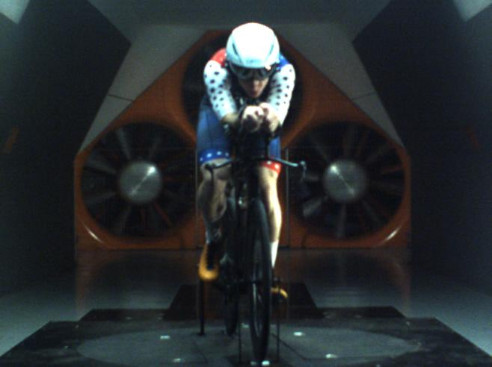

Thanks for the reply!
Counter points on the flat pedals:
Most people riding flats are total newbies on the bike. You are probably blasting past them for that reason
None of the people I observed with platform pedals were newbies. They were all experienced duathletes using platforms that had a toe clip, supported their entire shoe and even something that sort of cupped their heel.
Time trials (draft illegal duathlons) are pretty sterile. I don’t think they are that different from riding an indoor trainer/erg hard
**I’m really curious now. Have you actually tested this out on your own, outside on the road? I see people quote studies all the time when they want to justify not changing shoes in transition, but as an experienced cyclist, this should not be that hard for you. Set up your Run/Bike/Run course and see if you can duplicate your bike/run efforts while not wearing cycling cleats and then match your run. Personally, I can’t imagine I could even come close to my times in regular shoes on the bike. My rpm is very high and there is no way I could do that without being connected to the pedals. **
Re the old guys:
I have no doubt the number you showed make it difficult to believe someone could be beating you. I also suspect you could write whole books about what those guys know about competing that you don’t.
**I would be curious to know what sort of run volume you are doing and for how long and what running background you have. If you were a 4:20 miler in high school, and you are running 50-60 mpw right now, then no, you should not be getting beat by anyone. But if you are running 30 miles per week then it would not shock me at all that you are getting beaten by old guys. The shortest duathlon I’ve ever done was 5K/20K/2.5k and that took about an hour. 60 minutes of aerobic work is not a sprint, it is still an endurance event and those old guys have probably been at it for 10-40 years if they are anything like me. **
Nothing shouts “old school” to me like using tubulars! Tufo doesn’t exactly top the charts of bicycle rolling resistance website, and that’s using the modern tubeless versions.
**Tufo tubulars were infamous in the mid-2000s for being popular because they were vulcanized, super-light, could be pumped up to 160 and they were fairly tough. It took smart guys with power meters and test machines to show that those things were terrible. And even worse with the Tufo glue tape. I never could figure out why I never got faster with my amazing Zipp 404/Disc wheels when I raced until I realized I was giving up huge watts because of my tires. **
I didn’t mean to imply I could “only” be a duathlete. I’m in Minneapolis, we’ve got lots of sports here.
Mostly I meant where do you live that there are enough duathlons to keep you occupied. In the 2000s In Viginia and California I could find enough duathlons I did not feel obligated to swim. Those dried up in the teens and then I started coaching high school. When I came back five years later, duathlon in Cali had gone the way of the dodo.
thanks for the discussion, hope I didn’t ruffle too many feathers
p.s. Don’t be in a hurry. I was never faster than when I was 38 years old. But then, I was clueless about how to train in my 20s and early 30s, so there was nothing magical about 38. Just the culmination of years of massive volume training.
Thanks for sharing your interesting findings.
What flat pedals did you choose, why did you choose them etc. I have been thinking about this for a while and am reading about concave designs etc. Do you like pins? What size pedal body did you go for? Was there a difference in stack height of flat pedals?
These are some of the things I’m thinking about.
I don’t do a particularly high cadence. Mid 80’s usually. I grew up with a coach from the era where “spin over 100 rpms, that’s how the elite do it” but never found it that great myself. Again, self-selected cadence is what comes out in most studies, rather than turbo rpms. I do find hitting really high RPMs helps for sprinting and short intervals, but not for time trials. Which is a point to reinforce: for lots of road racing, cycling shoes are definitely better. But for steady state duathlon/triathlon, I am failing to see the difference.
I’ve been riding exclusively flat pedals on my time trial bike for the last year, and have switched a road bike over as well now this spring. And I have been able to manage KOMs on segments with flat pedals, which is the only really benchmark I have there. I feel great riding in them, but the bike fit is different and took a month of me playing around with it to get right, which is an important point. I suspect people who have bad experiences switching to flat pedals have issues with the fit not being quite right, and losing power that way.
My selection criteria for flat pedals was “as thin as possible”. I first used the Canfield Crampon Ultimate and now have the Wolftooth Ripsaw Aluminum as well. I think I like the Wolftooth a bit better, they are also made not far from me so I have that bias.
I had a bad experience with one pair of flat pedals (RaceFace). At first I really liked them for being light. I bought them to fly with, I raced the dutch Duathlon national championships last August on a converted road bike, in the Netherlands (where I got totally creamed). One of the pedals fell off mid race. The threads were too soft. Now I stick to very expensive flat pedals.
I have also been annoyed at lots of pins on flat pedals because they can really dig into your leg if you aren’t careful when walking around them. They can tear off skin quite effectively. That said I also did a race in the rain on flat pedals and I appreciated the pins then. Cycling shoes are definitely a little nicer in the rain, the pedals while cornering (although off the bike, in the rain, they are even more dangerous, whereas running shoes have much better grip on the ground when wet). So I would probably vote for having more pins if you ever expect to ride in the rain.
Flat pedals tend to be wider so when you are cornering you are more likely to strike your pedal if pedaling through the corner. I’ve switched to shorter crank arms so that isn’t as much of an issue, but something to remember.
Maybe it is just me, but I haven’t noticed too much difference between concave and convex. The giant layer of foam on the Alphafly’s’ might be a factor there, absorbing the slight variations so that my foot doesn’t notice.
Fit is very different. I believe my saddle is about 2 cm higher (I’ve got marks on the seat post to easily switch between the two). My position on the saddle is also slightly different between cycling and running shoes. As I said above, it look me a while to dial in my fit for flat pedals, at first I was pretty uncomfortable. Also you can move your foot around on the platform mid race, which is odd at first. Unlike cycling shoes, where I clip into my fit spot exactly, sometimes I jump onto the bike and start pedaling with the foot too far forward or backwards on flats, but luckily moving the foot is easy.
Am I missing something here? When you say flat pedals for racing with running shoes you literally mean flat pedals…not clipped in in any way? No toe straps even? If so then irrespective of how fast they are in T1/T2 or how aero they are you are losing immense amounts of power by not utilising your glutes for cycling? Efficient cycling is a circular motion not just pushing down on the pedals. Have you tested how much faster you are while clipped in versus flat pedals?
Back in the day, when run shoes were pretty simple affairs with a thin strip of fairly firm foam you could get away with racing on the bike in them with something like a pedal adaptor, but if you were serious never just flat pedals.
how aero they are you are losing immense amounts of power by not utilising your glutes for cycling? Efficient cycling is a circular motion not just pushing down on the pedals.
That’s the argument is there have been various studies that found not only no loss of immense of amount of power, but little-to-no difference in efficiency whatsoever. Except in sprinting - where clipless pedals have a clear advantage.
Though as pointed out above these studies were narrow in design, so may not have captured the ranges of conditions experienced in real life. E.g. this study stopped at 150W, which is Slowtwitch backpedaling.
More than the flat pedals I’d be a bit worried about the AlphaFly cushioning. Whether all that cushion compression is lost energy or returned to the pedal on decompression, I have no idea. But I’d just wonder about it - the dynamics of compression while pedaling may be very different from what happens while running.
You could do a simple test. Ride at target power on an indoor bike with flat pedals and Alphafly’s and do a run off. Repeat with bike shoes ensuring efficient pedalling and utilising glutes. Measure heart rate and RPE.
There is now way it will be faster or feel better.
additionally in the real world of corners and hilly courses I’d be concerned about my feet coming off the pedals.
additionally in the real world of corners and hilly courses I’d be concerned about my feet coming off the pedals.
Possibly. I sometimes use flat pedals mountain biking to improve my MTB technique, and feet coming off is not much of an issue even for black diamond terrain. But those MTB pedals have pins, and the MTB flat pedal shoes are designed to work with the pins. They lock in the shoe so well that for all kinds of lateral/forward/back pressures they feel every bit as secure as SPD pedals.
I absolutely would not wear expensive running super shoes on my pinned pedals. I suspect those pins could tear up the ultralight sole in a hurry.
But I suspect that the grippy soles of running shoes would work OK with unpinned pedals. That said, I’ve never tried it.
One and a half years since I switched to flat pedals for duathlon racing, still riding plenty in cycling shoes too, and all I can say is it works great for me. As I keep saying, if you try it, make sure your fit is correct.
Pins haven’t damaged my alphafly or sauncony endorphin speed 3s yet despite plenty of miles. You shouldn’t really be ripping your shoe across the pedals. I could see damage happening in a crash or in a sloppy mount or dismount, maybe, but it’s a stretch.
I think the science is pretty clear on efficiency. Here’s a video for those who prefer that: https://www.youtube.com/watch?v=KUEaN9FKGLE
Still need more data on how stiff carbon fiber plates and/or huge amounts of foam in certain shoes might change things.
But I had never seen any aerodynamics data on this topic, so now you have it. Running shoes are indeed clearly slower in the wind, but for medium distances, it isn’t really enough to make up for the benefits in transitions in duathlon. And I would go so far as to say any draft-legal race or short triathlon should be done in flats, for those brave enough to try.
Are there other duathlons besides nationals that draw a larger, more competitive crowd?
The biggest I have ever done was the one in Bourne, Netherlands last year (Run Bike Run Bourne). I highly recommend a trip. Huge event, massive crowds. Seriously, must have been a thousand people cheering like this was the Boston Marathon. I’ve never seen anything remotely like it here for duathlon or triathlon.
A lot of the local duathlons have had decent sized fields, I recently did a little one here in Lake Elmo, MN that had, 62 people, enough to feel like a race. Many triathlons too have a solid duathlon field. But most of the people are doing it for fun, the depth of competition is way, way lower than a bike race field with 62 people would have.
Someone needs to make duathlon cool.
Had an idea on the flat pedal front, which I just tried on the trainer. Wearing cycling shoes, try unclipping and pedaling with just one foot for a while. I did this and my lifting up part of the pedal stroke muscles get really tired, really fast. It is clear that I rely on the push up from the crank from power on the other side, and at least for me, there is no significant lift up happening contributing to my power. I know some para athletes manage one footed quite well, so maybe some people do rely on those muscles a lot more, but at least for me, it’s not important (outside sprinting, perhaps).
That is my fear about spongy soles of new supershoes.
I’m probably going to race with flat pedals next spring (at least for a few races) but I’ll use my flats instead. Smaller shoe should be more aero than my asics metaspeed and smaller stack height hopefully means feeling more connected to pedal and no adjustment to saddle.
The biggest
Someone needs to make duathlon cool.
That is never going to happen and here is why: 1) money 2) pain.
slowman once wrote a reply to a duathlete complaining about lack of races and he basically said that Ironman won the multisport war by making their races EVENTS. Not just a race but some more to the people competing. Location and the production matter. You would have to spend a lot of advertising money to make duathlons really epic so that people are inclined to spend money to go to those race and sell them out ten minutes after opening. Unfortunately that will probably never happen because of 2)
The level of pain or discomfort that comes from running twice can’t really be overstated. If people were less competitive and could pace properly then the second run of a duathlon would not be so bad, but they are competitive and they don’t pace well, soooo… they start the second run half cramping and feeling like death-warmed-over and they never want to race a duathlon again. I’m not sure that is a barrier you can overcome easily.
I once conducted an informal ST survey to see what sport triathlete like the least. Swimming won out handily (It was about 50 percent disliked swimming, 30 percent did not like running and 10 percent did not like cycling and 10 percent loved all three).
Despite this, most of them said they would not consider duathlon It has no buzz and you have to spend most of your time explaining that you are running twice, not skiing and shooting.
Had an idea on the flat pedal front, which I just tried on the trainer. Wearing cycling shoes, try unclipping and pedaling with just one foot for a while. I did this and my lifting up part of the pedal stroke muscles get really tired, really fast.
The research I have found showed that even trained cyclist do not contribute power when they are pulling up on the pedals. What does happen is they are somewhat unweighting the pedal so that your down-pushing leg/foot is not having to overcome the weight of the leg/foot going up. The reason you have to ‘mash’ with out cycling shoes/pedals is that you have no way to unweight that up going pedal. Spinning higher rpm contributes to a more even pedal stroke an more ‘unweighting.’ Now, since the muscles pushing down are far stronger than the ones you use to pull up, this is not likely a huge disadvantage, but it may matter.
One last thought for you and I’ll stop raining on your flat pedal parade. Every so often someone comes along and tells people they would be faster and save time by not having to switch shoes and cite studies done in labs to show it does not matter. When that happens I usually go out and do a few tests to see how much switching shoes matters.
I now have a power meter to make it even more useful, so I went out today after my run workout and timed a couple of transitions. I simulated a run into transition, putting on the helmet, grab the bike, run out of transition, mounting and then riding for a couple of minutes at speed noting the power required so it would be the same each time. My first test with running shoes took 2:16. My second with shoe switches took 2:21. So five seconds is what you gain and that was without even any transition practice. I suspect I could get into my shoes more smoothly on the bike with practice. However, my feet also slipped off the pedals a couple of times and I had to stop pedalling and reposition, which I suspect would also improve with practice. Coming into transition was about three seconds, i.e. the time it took to pull on my shoes. So, flat pedals and running shoes gain you 8 seconds.
I would guess that was pretty typical with my du race experience; it was not nothing, but it wasn’t much. So 8 seconds weighed against the comfort and efficiency at high rpm of cycling specific shoes. Not a win for me.
You have obviously made up your mind on this and that is fine, but anyone else considering it should know the cost/benefit.
The reason you have to ‘mash’ with out cycling shoes/pedals is that you have no way to unweight that up going pedal.
I would contest the claim that you have to mash without cycling shoes/pedals. Speaking of the BMX and enduro MTB guys I see able to spin to 200 cadence and beyond. They get to be pretty smooth/supple looking in pedal stroke.